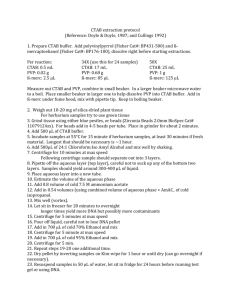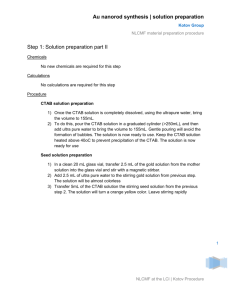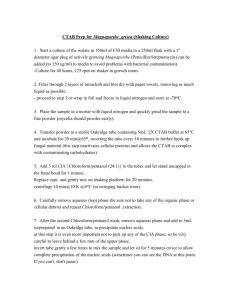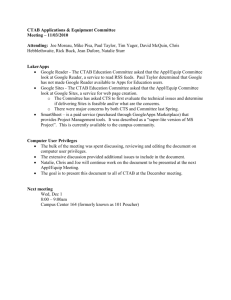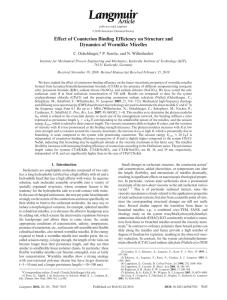Materials & Reagents
advertisement
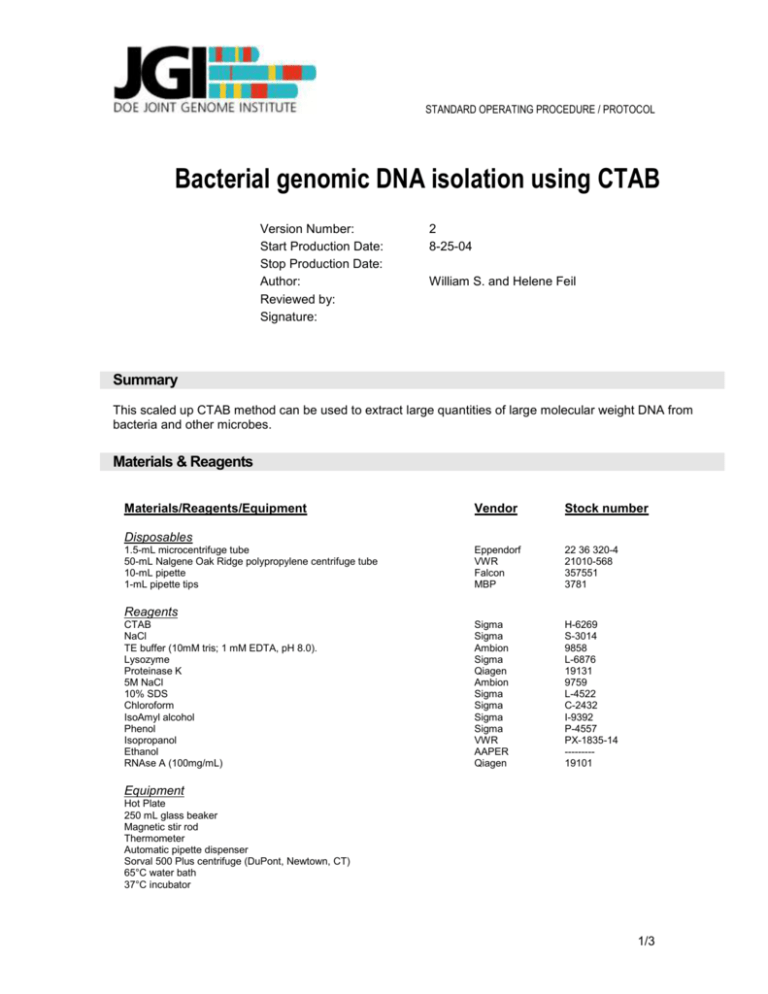
STANDARD OPERATING PROCEDURE / PROTOCOL Bacterial genomic DNA isolation using CTAB Version Number: Start Production Date: Stop Production Date: Author: Reviewed by: Signature: 2 8-25-04 William S. and Helene Feil Summary This scaled up CTAB method can be used to extract large quantities of large molecular weight DNA from bacteria and other microbes. Materials & Reagents Materials/Reagents/Equipment Vendor Stock number Eppendorf VWR Falcon MBP 22 36 320-4 21010-568 357551 3781 Sigma Sigma Ambion Sigma Qiagen Ambion Sigma Sigma Sigma Sigma VWR AAPER Qiagen H-6269 S-3014 9858 L-6876 19131 9759 L-4522 C-2432 I-9392 P-4557 PX-1835-14 --------19101 Disposables 1.5-mL microcentrifuge tube 50-mL Nalgene Oak Ridge polypropylene centrifuge tube 10-mL pipette 1-mL pipette tips Reagents CTAB NaCl TE buffer (10mM tris; 1 mM EDTA, pH 8.0). Lysozyme Proteinase K 5M NaCl 10% SDS Chloroform IsoAmyl alcohol Phenol Isopropanol Ethanol RNAse A (100mg/mL) Equipment Hot Plate 250 mL glass beaker Magnetic stir rod Thermometer Automatic pipette dispenser Sorval 500 Plus centrifuge (DuPont, Newtown, CT) 65°C water bath 37°C incubator 1/3 STANDARD OPERATING PROCEDURE / PROTOCOL Procedure Cell preparation and extraction techniques. (Modification of CTAB method, Current Protocols in Molecular Biology) 1.5ml 30ml 60ml 7. Transfer given amount of cell suspension to a clean centrifuge tube. ------- 740µl 14.8ml 29.6ml 8. Add lysozyme (conc. 100mg/ml). Mix well. 20µl 400µl 800µl 40µl 800µl 1.6ml 8µl 160µl 320µl 1. Grow cells in broth and pellet at 10,000 rpm for 5 min or scrape from plate. 2. Transfer bacterial suspension to the appropriate centrifuge tube. 3. Spin down cells in microfuge or centrifuge at 10,000 rpm for 5 minute. 4. Discard the supernatant. 5. Resuspend cells in TE. 6. Adjust to OD600 1.0 with TE buffer (10mM tris; 1 mM EDTA, pH 8.0) ------------------------------------- This step is necessary for hard to lyse gram (+) and some gram (–) bacteria. 9. Incubate for 5 min. at room temperature. 10. Add 10% SDS. Mix well. --------------------------------------------------------- 11. Add Proteinase K (10mg/ml). Mix well. ---------------------------------------- 12. Incubate for 1 hr at 37°C. 13. Add 5 M NaCl. Mix well. ----------------------------------------------------------- 14. Add CTAB/NaCl (heated to 65°C). Mix well. 100µl 2ml 4ml -------------------------------- 100µl 2ml 4ml ---------------------------- 0.5ml 10ml 20ml 0.5ml 10ml 20ml 15. Incubate at 65°C for 10 min. 16. Add chloroform:isoamyl alcohol (24:1). Mix well. 17. Spin at max speed for 10 min at room temperature. 18. Transfer aqueous phase to clean eppendorf (should not be viscous). 19. Add phenol:chloroform:isoamyl alcohol (25:24:1). Mix well. --------------- 20. Spin at max speed for 10 min at room temperature. 21. Transfer aqueous phase and add 0.6 vol isopropanol (-20°C). (e.g. if 400 l of aqueous phase is transferred, add 240 l of isopropanol. ---- Add 0.6 of vol. ---- 22. Incubate at room temp for 30 min. 23. Spin at max speed for 15 min. 24. Wash pellet with 70% ethanol, spin at max speed for 5 min. 25. Discard the supernatant and and let pellet dry for 5 – 10 min at room temp. 26. Resuspend in TE plus RNAse (99 l TE + 1 l RNAse (10 mg/ml)). -------- 20µl 400µl 27. Transfer to sterile microcentrifuge tubes. 28. Incubate at 37°C for 20 min. 29. Run 1 l in a 1% agarose gel with concentration standards. 2/3 800µl STANDARD OPERATING PROCEDURE / PROTOCOL Notes and precautions. In step 1, do not use too many bacterial cells (an OD600 of not more than 1.2 is recommended), or DNA does not separate well from the protein. Most of the time, inverting several times is sufficient to mix well. Shaking too hard will shear the DNA. Use any protocol for DNA precipitation, the one in this protocol works well. Reagent/Stock Preparation CTAB/NaCl (hexadecyltrimethyl ammonium bromide) Dissolve 4.1 g NaCl in 80 ml of water and slowly add 10 g CTAB while heating (65°C) and stirring. This takes more than 3 hrs to dissolve CTAB. Adjust final volume to 100 ml and sterilize by filter or autoclave. 3/3
